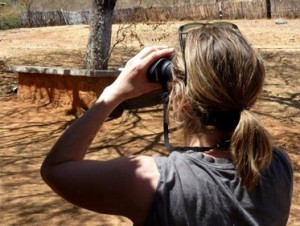1. Tell us a little bit about your aesthetic inclinations?
Like the best ornithological taxonomists, of which I’m not, I’m a splitter—when I write, I find myself breaking into what I’ve already written—maybe second guessing it, maybe just throwing something next to it that sheds some different sort of light on it. My ultimate goal is some sort of dimensionality to the work in the way that setting up a decent house of cards requires undercutting and opposition.
Essentially, I do not believe language can ever be truthful on its own. It needs space and opposition for something real to emerge. “Literary” work that doesn’t recognize this seems to me problematic.
2. Where did you come from and are you happy that you’re no longer there?
I came from San Diego; and I come from a line of folks on either side that headed out to California in the late 19th/early 20th centuries. I am both happy and not happy. I have to say, the quail, the desert and the ocean are three big reasons I am not glad I’m no longer there.
3. What does your work demand? What does it offer?
My work demands that the reader bloody well relax and let the work do what it needs to do. It offers, I hope, a space of fusion—the fantastic, perhaps, but also the biological and the historical. It also often offers quail.
4. Where do you do what you do?
Wherever I can—I don’t have much choice right now though I’d rather be doing it in the ocean or in Mexico surrounded by quail.
5. If push came to shove…
I get out my hammer
6. Please tell us about beauty, belief or bawdry. You may begin.
Isn’t beauty why we war? Or is that too simple? I suppose we war because of pettiness and power. Beauty is in the vast time of the earth and the 4.5 billion years life has been evolving on her. Beauty is also dirty dishes in a certain light and certain writings and my children, of course. Belief is everything but is an especial challenge for me. That is why I need to spend time with the quail—that is where my belief comes back. Bawdry is what is inside but is tamped down in the presence of other.
7. As Gertrude Stein says “let us why why.” Please proceed.
I am wearing a green ribbon around my neck for luck. I appreciate the color green as I appreciate the fact that sleep has overtaken us and the gentle lift of the water under a boat or under my body. If I were green I might not appreciate it. But I am not. Currently.
8. What does art do to you?
Emily Dickinson and Franz Kafka said it best—I cannot do any better.
9. Who (or what) do you admire?
PJ Harvey (I’m currently obsessed with her new album), quail, the movie Ghost Bird, Emily Dickinson’s work and Susan Howe’s My Emily Dickinson, my kids, people who are generous—honestly, this could go on and on…Two relatively recent non-figgy books—Julie Carr’s 100 Notes on Violence and Maggie Nelson’s Women, The New York School and Other Abstractions. And of course—all the figs.
10. What is a good question? What questions do you ask?
What the fuck? Honestly, it is a good question.
Some of my specific questions
- What are the behavioral differences between Callipepla quail species?
- What does it mean that the participants in WWI are pretty much dead? Were the young men who fought DOA home no matter whether they survived or not? Is it true or am I naïve—does the person who was in the battle die there and, if he/she survives, walk out of the valley or the plain a person separate from that other person?
- What does California mean?
- Is it possible for writing and art to embody another species? Is it useful? Is it necessary?
11. What do you find deeply satisfying?
Field work with quail, yoga and running a trail, discussions of the darkest humor with my children, writing—being completely entered into to a piece of writing, using curled up cats as pillows, lifting chickens.
12. What are your favorite kinds of figs?
Every kind (even the ones with little wasps inside)
JENNIFER CALKINS is an evolutionary biologist, poet and mother. She lives in Seattle with her family and other animals. Her book, A Story of Witchery, was published by Les Figues Press. You can visit her at her website.

Comments are closed.